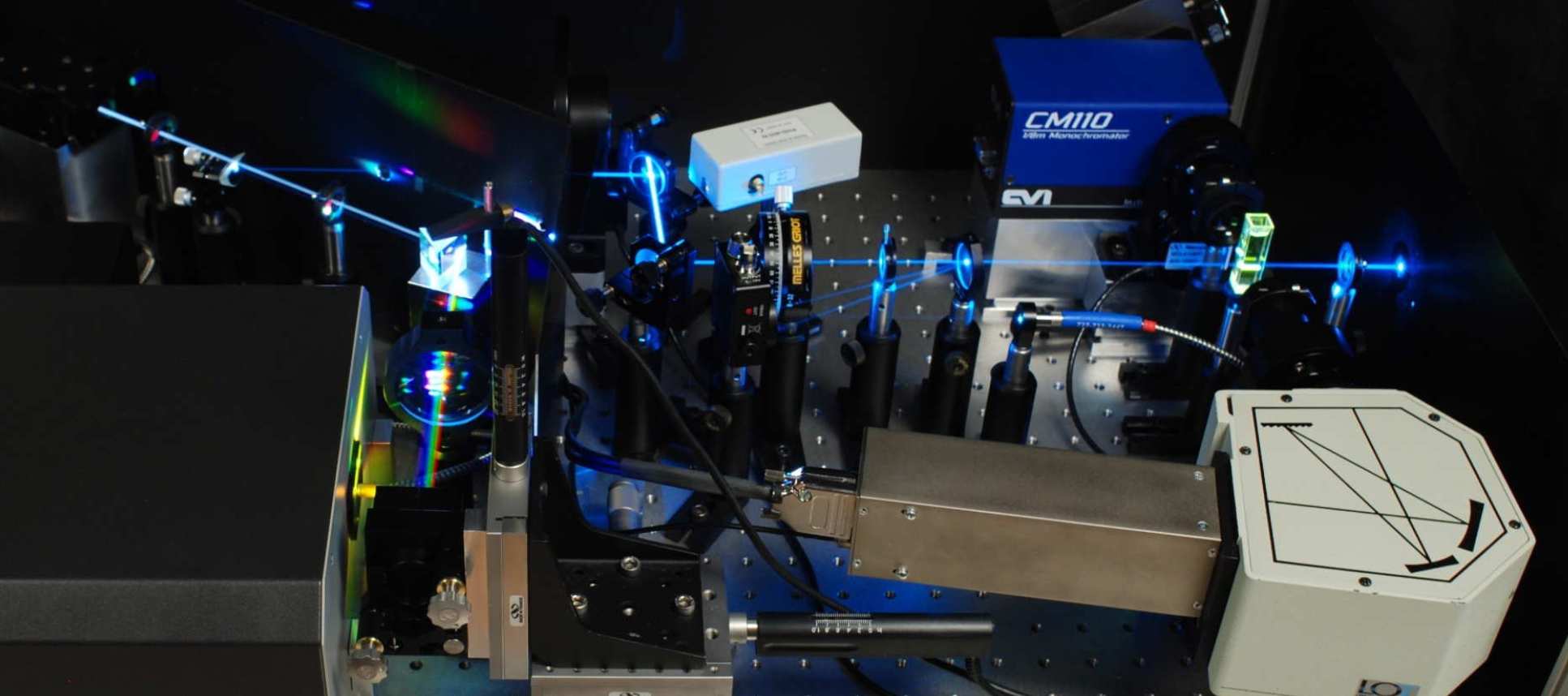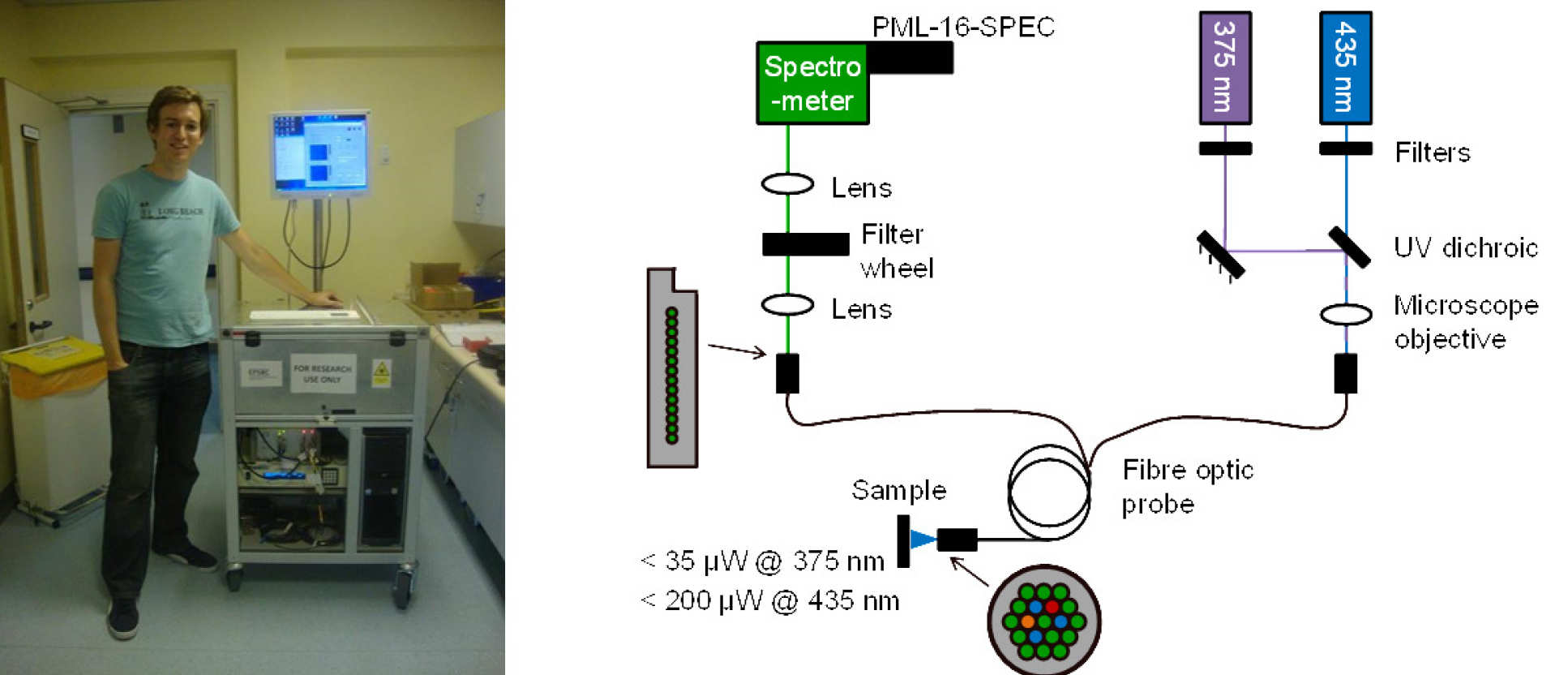Funded by a BBSRC grant under the Tools and Resources Development Fund, we developed a novel time-resolved automated fluorometer in 2008 that utilises a fibre-laser-pumped supercontinuum source for versatile excitation and time-correlated single photon counting (TCSPC) detection for fluorescence lifetime measurements. The instrument is also equipped with polarisers and a spectrograph or motorised spectrometer to permit convenient and automated fluorescence measurements resolved with respect to excitation and emission wavelength, fluorescence lifetime and polarisation in a single measurement. This instrument [1] was applied to study cell biology, characterising membrane probes and fluorescence proteins for FRET studies, and to preclinical imaging, exploring the application of autofluorescence lifetime as a readout of collagen degradation to potentially provide a diagnostic tool for osteoarthritis.
 Excitation-emission-lifetime-polarisation-resolved fluorometer utilising a tunable fibre-laser pumped supercontinuum excitation source and time-correlated single photon counting
Excitation-emission-lifetime-polarisation-resolved fluorometer utilising a tunable fibre-laser pumped supercontinuum excitation source and time-correlated single photon counting
We have subsequently adapted this instrument for clinical and preclinical applications. Using gain-switched diode lasers to provide picosecond pulsed excitation, we constructed a portable trolley-based version with fibre-optic probe for single point spectrally-resolved autofluorescence lifetime measurements.

Clinical time-resolved fluorometer for spectrally-resolved autofluorescence lifetime readouts via a fibre-optic probe
This instrument and similar implementations were applied to ex vivo [2] and in vivo [3] clinical studies exploring autofluorescence lifetime-based readouts of skin cancer. It was also applied to ex vivo [4] and in vivo studies of gastrointestinal cancer and to ex vivo studies of osteoarthritis [5]. A version of this instrument was also applied to explore readouts of metabolic changes in plants, specifically looking at the impact of agrichemicals on Photosystem II [6].
Multidimensional fluorometry references
- A compact, multidimensional spectrofluorometer exploiting supercontinuum generation
H.B. Manning, G.T. Kennedy, D.M. Owen, D.M. Grant, A.I. Magee, M.A.A. Neil, Y. Itoh, C. Dunsby and P.M.W. French
J. Biophoton. 1 (2008) 494–505 - A hyperspectral fluorescence lifetime probe for skin cancer diagnosis
P. A. A. De Beule, C. Dunsby, N. P. Galletly, G. W. Stamp, A. Chu, U. Anand, P. Anand, C. D. Benham, A. Naylor and P. M. W. French
Rev. Sci. Instr. 78 (2007) 123101 - In vivo measurements of diffuse reflectance and time-resolved autofluorescence emission spectra of basal cell carcinomas,
Alex J. Thompson, Sergio Coda, Mikkel Brydegaard Sørensen, Gordon Kennedy, Rakesh Patalay; Ulrika Waitong-Brämming, Pieter A. A. De Beule, Mark A. A. Neil, Stefan Andersson-Engels, Niels Bendsøe, Paul M. W. French, Katarina Svanberg, and Chris Dunsby,
J. Biophotonics 5 (2012) 240-254 - Fluorescence lifetime spectroscopy of tissue autofluorescence in normal and diseased colon measured ex vivo using a fibre-optic probe
S. Coda, A. J. Thompson, G. T. Kennedy, K. L. Roche, L. Ayaru, D. S. Bansi, G. W. Stamp, A. V. Thillainayagam, P. M. W. French and C. Dunsby,
Biomedical Optics Express 5 (2014) 515-538 - Detection of cartilage matrix degradation by autofluorescence lifetime
H B Manning, M B Nickdel, K Yamamoto, J L Lagarto, D J. Kelly, C B Talbot, G Kennedy, J Dudhia, MJ Lever, C. Dunsby, PMW French and Y. Itoh
Matrix Biology 32 (2013) 32–38 - In vivo label-free mapping of the effect of a photosystem II inhibiting herbicide in plants using chlorophyll fluorescence lifetime
E Noble, S. Kumar, F. Gorlitz, C. Stain, C. Dunsby*, P. M. W French*
Plant Methods (2017) 13:48